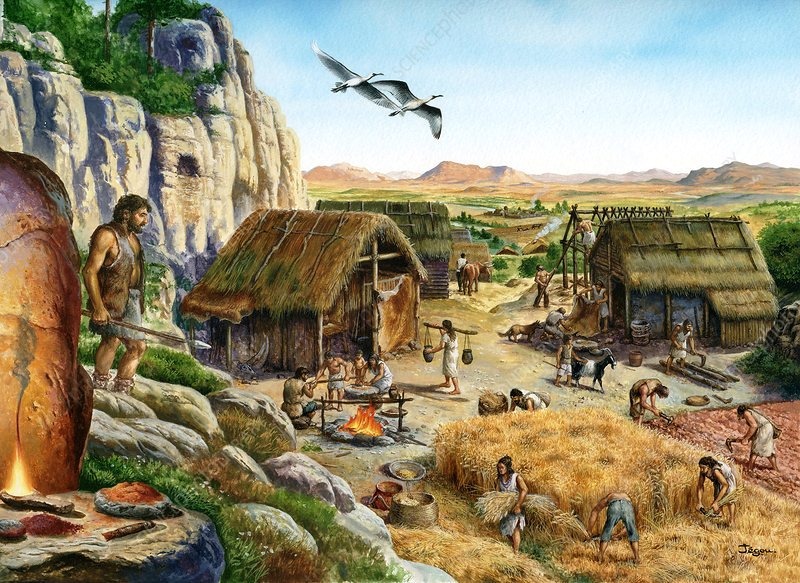Neolithic Period
The Neolithic Period extends between 8,000 and 4,500 BC, though many parts of the world would experience its characteristics at a later date; indeed, many parts of the world are still living in the "Neolithic" in the game's present day. The period as discussed here describes the initial advancement of technology and culture as it occurred during the time period specified.
The era marked a significant transition from hunter-gatherer societies to agricultural and settled communities. The domestication of wild plants and animals led to the establishment of a complex social structure, and the gradual development of technologies such as pottery, weaving and metalworking. This era also laid the foundation for the growth of civilisation in different parts of the globe.
Technology
The Early Neolithic saw the cultivation of plats like wheat, barley, rice and maize. The domestication of goats, sheep, cattle and swine allowed for a more stable and reliable source of food, spurring population growth. Pottery began to emerge around 6000 BC, with vessels used for cooking, food storage and water transportation. This led to innovations in food processing, preservation and social bartering. About this same time, cloth weaving became more sophisticated, widening choices in clothing, baskets and other items.
Late in the period, stone continued to be the primary material for making tools, though these became more specialised implements, such as sickles for harvesting and polished axes for woodworking and construction. Flint "knapping" (striking the flint to give it a flat face) techniques improved, resulting in sharper and more durable tools. Arrowheads and spears allowed for more efficient hunting and defense. Also in the Late Neolithic, mud-brick and wattle-and-daub structures appeared, offering improved shelter ("hovels") that improved protection from the elements. Other advances were made in ceremonial and ritual activities, trade and exchange, and art.
Human Culture
- Main Article: Humans in the Mesolithic-Neolithic Period
Scattered human cultures continued to grow in isolation throughout the northern hemisphere, along a fertile zone that promoted the growth of certain domesticable crops. Most of these would form no long-lasting significant culture, due primarily to the lack of archeological remains left behind.
After reaching its height in the 9th millennium, the Natufian culture in the Levant gradually faded away, becoming replaced by groups of isolated, indistinct entities of which little is known. While the Levant would see the rise of important city-states and kingdoms, especially with the onset of the Chalcolithic Period, during the Neolithic the communities here remained scattered structures moving slowly towards surplus populations and trade.
Çatalhöyük, in Anatolia, would grow as a powerful agricultural settlement after 7400 BC. Growing into a large town, the culture here would last nearly 2,000 years — but it would be abandoned because the agricultural progress during the Neolithic simply wasn't sufficient to support large settlements. The spread of disease and limited sanitation, with increasing dependence on fragile and thin trade, eventually disrupted the patterns of life here as it did the Natufian culture. Like situations occurred at Jiahu in Henan, China, and with the Hemudu culture in Zhejiang. Human interchange and culture wasn't efficient enough, or cooperative enough, to sustain these sorts of long-lasting civilisations long enough.
Ultimately, however, a late-Neolithic culture between the Euphrates and Tigris rivers, the Ubaid, would establish a pattern of urbanisation, agriculture and complex social structures was able to transform and transition into later cultural changes recognised as early Mesopotamian — specifically the Sumerians, who emerged inthe 4th millennium BC.
Elven Culture
- Main Article: Ancient Beleriand
Following a long dark period of disbandment, it wasn't until the Neolithic Period that elves in the New World began to transition towards agrarian societies. Due in part to a dangerous fall in birthrates, coupled with poor options in food supply and the disappearance of large animals, elvish society came close to perishing by the 8th millennium. However, adjustments in diet, discoveries in herbal medications and the development of a cooperative culture — both among themselves and nearby human natives — elvish culture began to coalesce in numerous small villages along the Sirion River (called the "Mississippi" by others).
Regaining knowledge of the bow, and learning to manage vast herds of deer in the forests, the elvish population increased throughout the Neolithic. By the late period, around 4500 BC, winter elves in the north had begun to repopulate the old Beringian lands, forming bonds that would later develop into the Anduin people.
Dwarvish Culture
- Main Article: Dwarvish History
Cultivation of the Khath Basin on the Upper Yenisey river rapidly increased dwarven populations after 5000 BC, as the first copper-and-tin smelting, however crude, followed investigation of mining and metals. The technology would not be shared, and would have to be rediscovered elsewhere. The Sayan Mountains initiated a search for silver and gold placer deposits that would propel cultures expanding in Tuvath and Rithdome.
Halfling Culture
- Main Article: Halflingish History
Migrations eastward produced groups of herding and agrarian cultures throughout Doggerland that thrived for 15 centuries, with numerous permanent villages and hamlets. This culture would be threatened by rising sea levels that began around 6500 BC, at which time the land would also begin to submerge. Within a few centuries, the Doggerland culture would disappear, as halflings took to the east in boats, crossing the North Sea to settle in southern parts of Scandinavia, notably Jutland, Terra Scania and Vestfold.
